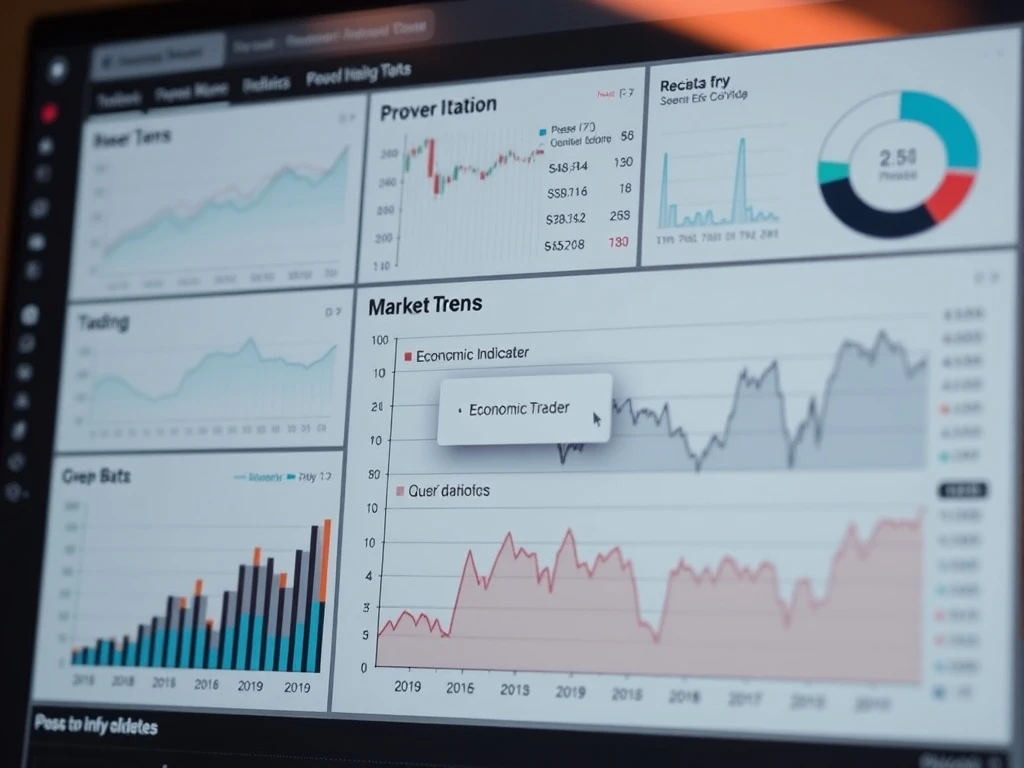Many investors closely monitor the Consumer Price Index (CPI). They believe it offers the clearest picture of inflation. However, this focus might be misplaced. Savvy investors understand that CPI often acts as a lagging **economic indicator**. It reflects past price changes. Therefore, relying solely on CPI can lead to delayed investment decisions. A more forward-looking perspective is essential for market success. This article will unveil a different, more critical **economic indicator** that demands your attention. It provides a clearer signal of future market movements and potential inflation trends.
Understanding the Limitations of the CPI Economic Indicator
The Consumer Price Index measures the average change over time in the prices paid by urban consumers. This is for a market basket of consumer goods and services. It serves as a primary gauge of inflation. Yet, CPI has inherent limitations. Firstly, it is a backward-looking metric. It reports what has already happened. Consequently, investors receive information after the fact. This makes proactive investment strategies difficult. Secondly, CPI data often undergoes revisions. These revisions can alter the initial picture significantly. Such changes create uncertainty for market participants.
Furthermore, many argue that CPI does not fully capture the true cost of living. Its basket of goods and services might not accurately reflect individual spending patterns. Some critics also point to methodological adjustments over time. They suggest these adjustments could potentially understate inflation. For instance, the substitution effect assumes consumers switch to cheaper alternatives. This can lower the reported inflation rate. Ultimately, while CPI remains a vital statistic, its utility as a predictive **economic indicator** for investors is limited. Therefore, a different lens is necessary.
Introducing the Producer Price Index: A Leading Economic Indicator
Instead of CPI, astute investors often turn their attention to the Producer Price Index (PPI). This powerful **economic indicator** tracks the average change over time in the selling prices received by domestic producers. It covers their output. PPI measures price changes from the perspective of the seller. This includes prices for raw materials, intermediate goods, and finished goods. It is a comprehensive measure of inflation at the wholesale level. Understanding PPI provides a distinct advantage. It offers insights into the costs businesses face before those costs reach consumers.
The Bureau of Labor Statistics (BLS) compiles and releases PPI data monthly. This report details price changes across various industries and stages of production. PPI is typically broken down into three main categories:
- Finished Goods: These are products ready for sale to the final user.
- Intermediate Goods: These are inputs into the production of other goods.
- Crude Goods: These are raw materials.
Each category offers unique insights. However, the finished goods index often receives the most attention. This is because it directly reflects prices for products ready to enter the consumer market. Consequently, it acts as a strong precursor to consumer inflation.
Why PPI Matters More: Its Predictive Power as an Economic Indicator
The Producer Price Index holds significant predictive power. This makes it a more valuable **economic indicator** for investors than CPI. Here’s why:
- Leading Indicator for CPI: Changes in producer prices typically precede changes in consumer prices. Businesses facing higher input costs often pass these costs onto consumers. This process happens through increased retail prices. Therefore, a surge in PPI today can signal higher CPI in the coming months. Investors can use this foresight to adjust portfolios proactively.
- Impact on Corporate Profit Margins: PPI directly affects corporate profitability. If producers cannot pass on rising costs, their profit margins shrink. This directly impacts company earnings and stock valuations. Monitoring PPI helps investors assess the health of corporate balance sheets. It also helps predict future earnings reports.
- Broader Economic Health: PPI offers a glimpse into the supply side of the economy. It reflects pricing power and cost pressures within various industries. A rising PPI might indicate strong demand. Conversely, a falling PPI could signal weakening demand or oversupply. This broader perspective on economic health is invaluable.
Therefore, focusing on PPI allows investors to anticipate market shifts. It provides a strategic advantage. It moves beyond simply reacting to past inflation data. This forward-looking approach is crucial for navigating volatile markets effectively.
PPI vs. CPI: A Comparative Analysis of Economic Indicators
While both PPI and CPI measure inflation, they do so from different vantage points. Understanding these distinctions is crucial for investors. They represent distinct facets of the inflationary landscape. Consider the following comparison:

A visual comparison highlighting the distinct roles of PPI and CPI as economic indicators.
| Feature | Producer Price Index (PPI) | Consumer Price Index (CPI) |
|---|---|---|
| Perspective | Seller (producer) | Buyer (consumer) |
| What it Measures | Prices received by domestic producers for their output | Prices paid by urban consumers for goods and services |
| Timing | Often a leading **economic indicator** for consumer inflation | Lagging **economic indicator**, reflecting past consumer prices |
| Components | Raw materials, intermediate goods, finished goods | Food, housing, transportation, medical care, etc. |
| Direct Impact On | Corporate profit margins, production costs | Consumer purchasing power, cost of living |
As evident, PPI offers an earlier signal of inflationary pressures. This is because it captures price changes at an earlier stage of the supply chain. Consequently, investors gain valuable lead time. They can adjust their portfolios before these changes fully manifest in consumer prices. This distinction is paramount for strategic investment planning. It allows for a more informed response to economic shifts.
Interpreting the PPI Economic Indicator Data for Investment Decisions
Proper interpretation of PPI data is vital for making informed investment decisions. Investors should look beyond the headline number. Several key aspects warrant close attention. Firstly, focus on the **core PPI**. This excludes volatile food and energy prices. It provides a clearer picture of underlying inflationary trends. Volatile components can distort the overall reading. Therefore, the core PPI offers a more stable and reliable signal. It helps in discerning persistent price pressures.
Secondly, observe the month-over-month and year-over-year changes. Consistent increases suggest growing inflationary pressures. Conversely, sustained declines might indicate disinflationary trends. Pay attention to the direction and magnitude of these changes. Thirdly, examine the PPI by stage of processing. Rising prices for crude and intermediate goods can signal future inflation for finished goods. This provides a layered understanding of cost transmission. Finally, compare PPI trends with other **economic indicator** data. For instance, correlate it with manufacturing surveys or wage growth. This cross-referencing helps confirm trends. It also builds a more comprehensive economic outlook. Ultimately, a holistic approach to PPI data offers superior insights.
Investment Implications: Leveraging This Key Economic Indicator
Understanding the PPI allows investors to make more strategic decisions. This crucial **economic indicator** can guide portfolio adjustments. When PPI is rising, certain sectors and assets may perform better. Companies with strong pricing power, for instance, can pass on higher costs. This helps maintain their profit margins. Conversely, businesses with weak pricing power may see their margins erode. Therefore, investors might consider:
- Commodity-related investments: Rising input costs often boost commodity prices.
- Value stocks: Companies with strong balance sheets and established brands might weather inflationary pressures better.
- Inflation-protected securities: These instruments are designed to protect against rising prices.
Conversely, a falling PPI might signal disinflation or even deflation. This scenario could benefit consumer discretionary stocks. Lower input costs for businesses can lead to higher profit margins. This can also result in lower prices for consumers. Bond markets also react significantly to PPI data. Rising PPI often leads to expectations of higher interest rates. This can push bond yields up. Conversely, falling PPI can suggest lower inflation expectations. This could lead to lower bond yields. Ultimately, integrating PPI into your analysis enhances your investment strategy. It allows for a more agile response to market shifts.
Complementary Economic Indicators for a Holistic View
While PPI offers crucial forward-looking insights, no single **economic indicator** tells the whole story. A comprehensive investment strategy incorporates several data points. For instance, the ISM Manufacturing and Services PMI surveys provide valuable forward-looking data. These surveys gauge business activity and sentiment. They can signal economic expansion or contraction. Furthermore, wage growth statistics are important. Rising wages can fuel consumer spending. They can also add to inflationary pressures. These are distinct from producer costs. Therefore, they offer a different facet of inflation dynamics. Monitoring the yield curve also provides a powerful recession predictor. An inverted yield curve often precedes economic downturns. It signals investor pessimism. Therefore, combining PPI with these other indicators creates a robust analytical framework. This multi-faceted approach offers a truly holistic understanding of the economic landscape. It empowers investors to make well-rounded decisions.
Conclusion: Mastering the Economic Indicator for Smarter Investing
In conclusion, while the Consumer Price Index receives widespread attention, it often provides a rearview mirror perspective. Savvy investors understand the limitations of a lagging **economic indicator**. They instead focus on more predictive metrics. The Producer Price Index stands out as a critical, forward-looking tool. It offers invaluable insights into future inflation and corporate profitability. By analyzing PPI, investors can anticipate market shifts. They can adjust their portfolios proactively. This proactive approach minimizes risks. It also maximizes opportunities in dynamic economic environments. Therefore, move beyond the headlines. Integrate the Producer Price Index into your analytical toolkit. This strategic shift empowers you. It helps you make more informed and timely investment decisions. Ultimately, mastering this key **economic indicator** is essential for long-term success.
Frequently Asked Questions (FAQs)
What is the primary difference between CPI and PPI?
The primary difference lies in their perspective. CPI measures prices paid by consumers for goods and services. Conversely, PPI measures the average change in selling prices received by domestic producers for their output. CPI is a lagging indicator. PPI often acts as a leading **economic indicator** for consumer inflation.
Why is the Producer Price Index considered a leading indicator for inflation?
The Producer Price Index is considered a leading indicator because it tracks prices at earlier stages of the supply chain. When producers face higher costs for raw materials or intermediate goods, they often pass these increased costs onto consumers. This process happens through higher retail prices. Therefore, changes in PPI can foreshadow future changes in CPI.
How does PPI affect corporate profit margins?
PPI directly affects corporate profit margins. If the prices producers receive (output PPI) do not rise as quickly as their input costs (input PPI), their profit margins can shrink. Conversely, if output PPI rises faster than input costs, profit margins may expand. Monitoring PPI helps investors assess a company’s potential profitability.
What components of the PPI report are most important for investors?
Investors should pay close attention to the **core PPI**, which excludes volatile food and energy prices. This provides a clearer picture of underlying inflation trends. Additionally, examining PPI by stage of processing (e.g., crude, intermediate, finished goods) offers insights into where inflationary pressures are building within the supply chain.
Can I rely solely on PPI for my investment decisions?
No, relying solely on any single **economic indicator** is not advisable. While PPI is a powerful leading indicator, a comprehensive investment strategy incorporates multiple data points. Investors should combine PPI analysis with other indicators like the ISM PMIs, wage growth, and yield curve movements. This creates a more holistic and robust economic outlook for informed decision-making.
























